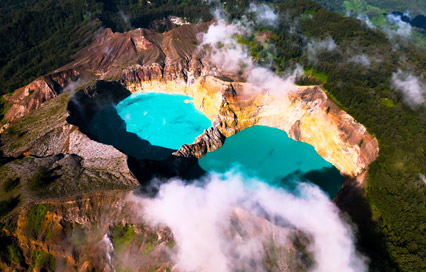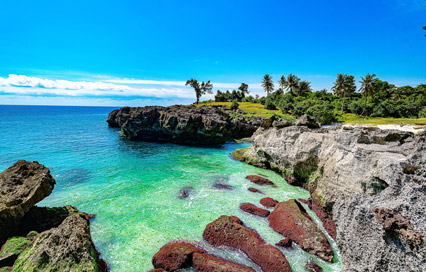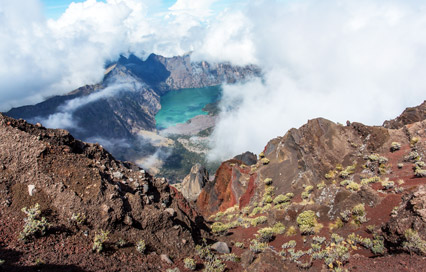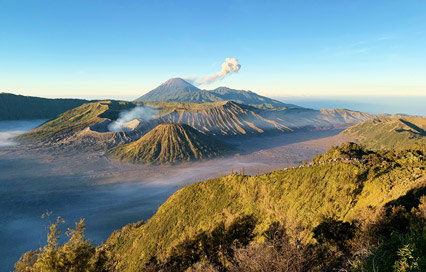Top 6 National Parks In Indonesia You Must Visit
October 10, 2024
There is little doubt that the largest archipelagic state in the Pacific Ring of Fire is home to a wide variety of unique ecosystems and animals. Probably, Indonesia is an amazing nation with diverse landscapes and unusual animals spread across many of its 17,000 islands and islets. The islands of Java, Sumatra, and maybe the most well-known, Bali, are the reason this Southeast Asian and Oceanic nation is so well-known.
Of course, a nation with this size and location would have a lot of places deserving of the designation as national parks. In actuality, there are more than 50 national parks in Indonesia. Here’s a guide to the top 6 national parks in Indonesia that you must visit.
Best National Parks In Indonesia At A Glance
The Southeast Asian country of Indonesia, which is made up of thousands of islands, is home to enormous tracts of wild, scenic beauty as well as a variety of national parks brimming with amazing and rare wildlife. This is our list of the best national parks in Indonesia.
Komodo National Park
Situated in the strait between Sumbawa and Flores, Komodo National Park is recognized as a UNESCO World Heritage Site. It serves as the native home to the Komodo dragon, the largest lizard in the world. While there are dragons on two other adjacent islands, visitors are only permitted on Komodo and Rinca to safeguard the natural populations.
Observing the dragons in their own environment is the highlight of a trip to Komodo National Park. The most well-liked hike in Komodo is a 2 km (1.2 mile) stroll to Banunggulung. You can make advance arrangements to travel past Banunggulung to Poreng, in the northeastern region of the island, if you would like to view more of the elusive reptiles away from the throngs of tourists.
Walks of a shorter length can also be taken from the Loh Liang ranger station to Kampung Komodo in the southwest. On both islands, hikers are required to be escorted by a park ranger, whose knowledge of animal behavior and where to find and identify animals. The security of the guests is another duty of the rangers.

Komodo National Park is recognized as a UNESCO World Heritage Site
West Bali National Park
Go to Bali's isolated western point if you love hiking, birdwatching, secluded beaches, and blue waters. West Bali National Park, a designated natural park since 1917, is powerful, with montane forests, arid savannas, and rainforest trails encircling two extinct volcanoes. One of the park's main attractions, the endangered Bali starling, is a sight to behold if you hike the Tegal Blunder Trail.
Hire a local boat and take a 30-minute journey to the nearby deserted island of Menjangan (Deer Island) for some of the best calm-water snorkeling in Bali. Take a 40-minute walk around the island to reach the massive whitewashed statue of Ganesha facing the sea, which is located past the stunning Hindu temple of Puri Gili Kencana.

West Bali National Park, a designated natural park since 1917, is powerful, with montane forests
Tanjung Putting National Park
Tanjung Puting National Park Indonesia, is renowned for its vast forests and rich fauna, particularly its population of orangutans. These reddish-brown apes are fed daily at one of the three park outposts (check times upon arrival).
The 1,602 square mile Tanjung Putting National Park borders the Sungai Sekoneyer River. Birdlife is abundant along riverbanks and in the trees, where you will find many avifauna. Along the riverbanks around dawn, when many animals start their daily foraging, there are probable viewing possibilities for the severely endangered orangutan species, which is protected and studied by research centers and conservation facilities outside the park's boundary.

Tanjung Puting National Park Indonesia is renowned for its vast forests and rich fauna
Bromo Tengger Semeru National Park
Bromo Tengger Semeru National Park Indonesia is one of the most popular volcanic locations and one of the best national parks in Indonesia.
You will need to leave your hotel at 3:30 am to witness the sunrise from Mt. Bromo, the island's most well-known active volcano. It is also worth it to see daybreak over the Tengger Massif range and the massive Mt. Semeru, which is 3676 meters (2.3 miles) high. After dawn, visitors proceed in 4WD through the sand sea, a lunar-like terrain, to reach the crater rim.
Hikers with a strong sense of adventure can traverse the stark, sweeping plain in an almost dreamlike experience. You will come across native Tengger riders on the ascent, dressed in traditional thick cloth to keep the cold at bay. It can get as cold as 4°C (39°F) in the morning, so pack a jacket, a woolly hat, and warm gloves. You can also rent a jacket there for about US$2.

Bromo Tengger Semeru National Park Indonesia is one of the best national parks in Indonesia
Baluran National Park
Baluran National Park, often nicknamed "Little Africa", is a striking desert savannah rich in wildlife that spans approximately 23,713 hectares (92 sq miles) in East Java and an additional 4155 hectares (16 sq miles) of oceanfront. Here, you might come across some water buffalo and herds of preening wild peacocks.
Baluran Indonesia is home to 56 clouded leopards, elusive protected cats that come out to hunt at night. Your best chance of spotting them is to spend an evening on the property; park rangers can authorize an overnight stay with special permission.
Leaf monkeys, endangered wild Asian canines, Javanese warty pigs, monitor lizards, fruit bats, squirrels, and civets are among the other species that are far simpler to identify. There are 155 species of birds that can be found, such as bee-eaters, white-throated needletails, and kingfishers. At Bama Beach, the main strip, there is a separate fenced area where you may have monkey-free dining. So pack your binoculars, swimsuit, and picnic lunch.

Baluran National Park is a striking desert savannah rich in wildlife
Way Kambas National Park
Visitors can be certain to see Sumatran elephants and rhinos at Way Kambas, a sanctuary located on the southwest coast of the island in South Sumatra. In addition to having broad grasslands, marshes, and estuaries, the park is home to the Sumatran Rhino Sanctuary, which is crucial to the continuous attempts to prevent the extinction of the Sumatran rhino.
The journey provides fantastic chances to see tigers, boars, and wild elephants that might come to the river's bank for a drink. There are resident kingfishers, lesser adjutants, woolly-necked storks, and pelicans, making for good birdwatching.
Way Kambas National Park is a prime example of national parks in Indonesia, with its distinctive ecosystems and wide range of species. So it is a must-visit destination for nature enthusiasts.

Visitors can be certain to see Sumatran elephants and rhinos at Way Kambas
Entrance To National Parks In Indonesia
Visitors must pay the admission charge and, in some situations, receive permission from the park administration in order to enter each of the parks. There is a significant disparity in the costs that foreign and local visitors pay despite the vast variety of rates. As a general rule, visitors from other countries typically pay admission fees that are three times higher than those of locals, though this largely relies on the park's regulations.
Explore National Parks In Indonesia At Your Pace
The national parks of Indonesia offer a particular wild beauty that reflects natural marvels, whether one is keen to explore the thousands of miles of coastline, go deep into the tropical rainforests, look for unique fauna or wade through virgin mangrove forests.
Make sure all of your travel paperwork is in order as you plan your amazing trip to one of the stunning national parks in Indonesia. For entry into this tropical haven, most visitors will require a visa. Thankfully, obtaining an electronic visa for Indonesia is a simple procedure that can be completed online via our website. You can obtain your visa with a few clicks and concentrate on the amazing experiences that lie ahead of you. Do not pass up seeing Indonesia's breathtaking scenery, unusual fauna and vibrant culture. Apply for your e-visa now to get started on your adventure and get ready to create lifelong memories!
Related Articles:
- Best Places To Visit In Indonesia For Your Travel Bucket List
- Top 10 Tourist Attractions In Indonesia For An Ideal Itinerary
- Best Things To Do In Indonesia Makes You Want To Visit Again
- The Best Attractions In Bali Indonesia For Your Bucket List
- Explore Best Time To Visit Bali: A Travel Guide
- The Ultimate Guide To The Best Places To Visit In Bali Indonesia
Tags




